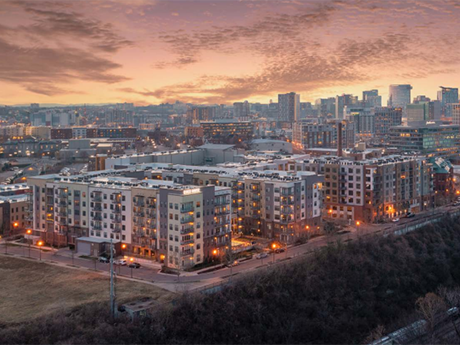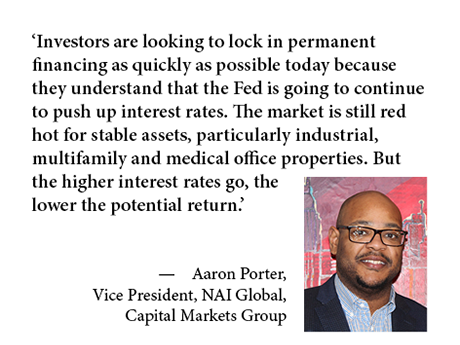DALLAS — Completing the lease-up and stabilization of new communities in a timely and cost-efficient manner is the most difficult aspect of developing active adult properties in the current environment. Such is the assertion of developers that are immersing themselves more deeply in this fast-growing sector of commercial real estate, which lies somewhere in between traditional multifamily and independent living on the spectrum of residential uses and services provided. The challenges of fast and effective lease-up programs are attributable to several factors that are unique to the emerging asset class, which also tussles with obstacles like rising construction and operating costs that are impacting all product types in all major markets. A panel of industry professionals with experience in developing and operating both traditional multifamily and seniors housing properties spoke to these challenges during the second-annual InterFace Active Adult conference on June 2. Held at the Dallas Downtown Marriott Hotel, the event also featured insight and analysis from lenders, investors and architects that are active in the space, as well as active adult renters themselves. Ryan Maconachy, vice president at Newmark, moderated the development panel, which kicked off the main day of the conference with a discussion of what the …
Features
Content PartnerFeaturesLeasing ActivityMidwestMultifamilyNortheastSoutheastTexasWalker & DunlopWestern
Walker & Dunlop: Spring Multifamily Market Contends with Inflation, Housing Bubble Fears
By Walker & Dunlop’s Research Department Inflation and a New Era of Monetary Tightening Amid 40-year high inflation rates, home prices that have surged by over 40 percent in the past three years and double-digit price increases in basic necessities such as food, gas and electricity, the United States seems to be beset on all sides. Inflation has become the question of the day with little relief even after monetary tightening began earlier in the year. After a quarter point increase in the Federal Reserve target rate in March, the Fed implemented a whopping 50 basis point increase in the target Federal Funds rate in May after April inflation remained at 8.2 percent, near the March high of 8.6 percent.[1] The central bank’s goal is to reduce inflation to an annual rate of approximately 2 percent. The employment base, the Fed’s other prime objective, seems to remain strong. Unemployment (at 3.6 percent in April) remains low and employment growth of 390,000 in May beat economist expectations. The Fed’s job now is to beat inflation and prevent it from becoming embedded in consumer expectations. Why? Because once inflation becomes embedded in expectations, it changes consumer behavior and becomes somewhat of a …
Florida Apartment Market’s Strong Real Estate Fundamentals Attract National, International Investors
by Jaime Lackey
There is an overall sentiment that the Southeast multifamily real estate market, and specifically Florida, is doing better than any other region in the United States. Despite record inflation, rising interest rates, increased construction costs and supply chain issues, investors, developers and lenders are becoming increasingly bullish when it comes to the Florida multifamily market. A rising population count resulting in a swift pace of rent growth and tight apartment vacancy have led to increased out-of-state and international interest and capital being invested in the state. With competitive yields and better returns compared with alternative investments, investors view Florida multifamily projects as a sound opportunity. Florida has been less stringent when it came to COVID-19 policies and lockdowns compared with restrictions adopted in the Northeast and on the West Coast. Limited and lenient state-wide restrictions in Florida during the health crisis allowed the state’s economy to recover more quickly than most major U.S. markets. In addition to an established migration of retirees, Florida has attracted a younger population, with workers looking for warmer climates and relaxed COVID-19 policies. Similarly, massive migration from other regions is being fueled by the ease of doing business, a favorable regulatory environment, business-friendly tax rates, …
Developers Turn to CPACE Financing to Achieve Better Returns Amid Rising Costs Environment
by John Nelson
By Jason Schwartzberg, President of MD Energy Advisors The real estate development industry has been negatively impacted by a continued series of hardships over the past 24 months, including rapidly escalating construction costs, breakdowns in the supply chain, inflation, labor shortages, rent freezes and, most recently, rising interest rates. Many projects are still managing to receive financing and get underway, but the current environment presents significant challenges for owners and investors to place a project under contract, achieve entitlement, obtain construction financing and then build, deliver and stabilize the development. For a project to move from concept to completion, it must first meet the internal rate of return (IRR) or hurdle rate, also known as the “minimum acceptable rate of return” (MARR). Developers and investors maintain various thresholds for the definition of an acceptable IRR, but the return of the project must ultimately be commensurate with the risk undertaken to complete it. Variables associated with construction and market risks also factor into the equation. There are several methods to increase a project’s return in order to reach a desired hurdle rate, some of which are outside of the developer’s direct control. Major inputs that significantly impact returns include the cost …
Build-to-RentContent PartnerFeaturesLeasing ActivityMidwestMultifamilyNortheastNorthmarqSingle-Family RentalSoutheastTexasWestern
Build-to-Rent (BTR) Property Type Offers Positive Demand Outlook
By Jeff Erxleben, president, debt & equity at Northmarq Liquidity and an incredibly positive outlook for single-family build-to-rent (BTR) properties is helping to offset some of the turbulence developers are experiencing from rising interest rates. Developers have been ramping up the pace of single-family BTR construction over the past five years with forecasts that call for a record high 60,000 new units to be completed in 2022. That volume shows a steady increase over the 53,000 units completed in 2021 and 49,000 in 2020, according to Northmarq’s recently released Single-Family Build-to-Rent Properties Special Report. Although financing across all property types has been impacted by upward movement in both short- and long-term borrowing rates, the BTR sector is in a good position to shake off those challenges and maintain its growth momentum. Higher construction and financing costs are being offset by rising rents with year-over-year rent increases, that in many areas of the country, are quite substantial. Developers also are finding good access to both debt and equity. The number of lenders that are active in the space is expanding as developers move into new markets and continue to prove out business models and performance with successful lease-up and dispositions. For …
By Eric Voyles, executive vice president, chief economic development officer, TexAmericas Center Whether you are considering moving your business to a new market, acquiring/merging with a competitor, adding staff or increasing your service lines, the risks of expanding an industrial business can be enormous. But with careful research, smart decisions and adequate support, the benefits to taking the next step for your business can far outweigh any negative pressures. For companies looking to expand, the considerations are extensive. Minimizing downtime and supply chain disruption are top priorities and planning ahead can help overcome those pitfalls. Consider these factors when making your decision: 3PL Support For many businesses, it will be the help of third-party logistics (3PL) services that will ultimately provide the best supply chain support and play the most pivotal role in helping reshape the world’s economy and allowing businesses to expand more confidently. There are several trends that have led companies to 3PL services, which help them minimize risk and outsource elements of their operations. Warehousing, fulfillment services, transportation of goods and management of labor forces are all benefits that 3PL companies can provide. Whether companies are manufacturing or distributing, they need flexibility. They are typically looking for locations …
Content PartnerFeaturesLeasing ActivityMidwestMixed-UseNAINortheastRestaurantRetailSoutheastTexasWestern
Which Way is the Retail Pendulum Swinging?
Although the pandemic wreaked havoc on the retail sector in general, the culling of weak concepts has left space for strong retailers to flourish. The retail industry is seeing an explosion in experiential retail, medical/dental space is ubiquitous and non-traditional tenants are jumping at opportunities to secure prime locations. As a result, shopping centers have proven very resilient, says George Macoubray, vice president of retail brokerage with NAI Elliott in Portland, Oregon. “Today’s centers continue to evolve and to address what consumers need in terms of a place for people to congregate and participate in the activities that are important to them.” The entertainment sector was hit hard by the pandemic, he notes. “But now those operators seem to be out looking for locations, and they’re seeing the light at the end of the tunnel. People want to gather. They want to be entertained. They want to go out and do activities. Those kinds of experiences are happening more and more often in shopping centers — and you can’t buy those activities on Amazon.” Exciting new in-person experiences are helping to elevate shopping centers. “There’s an influx of experiential retail. From golf simulator experiences to ping-pong places to axe-throwing activities, …
By Taylor Williams Well before a global pandemic barreled through the nation, destroying the jobs, savings and legacies of thousands of American businesses, launching a new restaurant was still a daunting task. According to 2021 data from National Restaurant Association, 30 percent of U.S. restaurants fail within their first year of opening. Relentless competition, high employee turnover, razor-thin margins, misfired marketing campaigns — all represent major operating minefields that come with such ventures. The industry is not for faint-of-heart entrepreneurs, and even with the aid of a healthy economy, a talented and experienced operator and a prime location, there are no guarantees of success. One might think that with COVID-19 causing food and beverage (F&B) businesses to fail and sending vacated spaces back to the market, finding quality locations at affordable rates would be feasible in the current environment. But that’s hardly the case in many major cities, especially those in states that implemented life-saving initiatives for its F&B operators early in the pandemic and has been “back to normal” for some time. Minimal Vacancy While F&B markets across numerous states are flush with pent-up consumer demand to eat, drink and socialize, the logistical and financial challenges of launching …
Capitalizing on a changing marketplace and employing technology to streamline processes are essential strategies in helping small balance clients meet their goals. Ana Ramos, managing director and regional production head at Walker & Dunlop, emphasizes the importance of speed, creativity and using technology to assist in mortgage lending processes. She also emphasizes the centrality of teamwork, company ethos and technology to put a big emphasis on small balance loans. Walker & Dunlop defines “small loan” as up to $15 million for multifamily properties with five or more units. These clients are usually composed of smaller individual investors who need attention and education when it comes to mortgage lending. “It’s really hard for a large producer to think small, but it’s really easy for small producer to think big,” Ramos says. “It’s difficult for producers who are accustomed to institutional lending, with its higher fees and complex vesting structures to consider the credit parameters that are necessary in small balance loans. Small loans is a niche type of mortgage lending, and it only works if you have a company within a company, like Walker & Dunlop with its dedicated small loan team that works together through application, underwriting and closing.” Tech’s …
Content PartnerFeaturesHealthcareIndustrialLoansMidwestMultifamilyNAINortheastOfficeSoutheastTexasWestern
Rising Interest Rates and Inflation to Fuel Change in Property Markets
Beginning in the fourth quarter of 2020, commercial real estate buyers and sellers moved off the sidelines and began fueling an impressive investment sales rebound as many pandemic-related lockdowns and restrictions eased or ended. The rush to purchase hard assets hit its apex a year later when commercial property sales surged to a record $362 billion in the fourth quarter of 2021 alone, according to Real Capital Analytics, a part of MSCI Real Assets that tracks property transactions of $2.5 million or more. The strong market is continuing this year: Deals of $170.8 billion closed in the first quarter, a year-over-year increase of 56 percent, Real Capital reports. Buyers in the first quarter also pushed up prices 17.4 percent over the prior year, according to Real Capital’s Commercial Property Price Indices (CPPI). But given rising interest rates and other recent headwinds, will investors continue to drive robust investment activity and bid up prices? The 10-Year Treasury yield has spiked some 150 basis points to around 3 percent since the beginning of 2022, and fixed 10-year mortgage rates of between 3 percent and 4 percent are up about 100 basis points. For short-term variable loans, the benchmark secured overnight financing rate …











